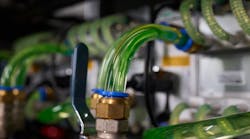Why Pressure Relief Vents Are the Silent Guardian of Inert Gas Fire Suppression Systems
With digital infrastructure now critical to every sector of business, the need to protect mission-critical facilities like data centers, telecom hubs, and industrial control rooms has never been more urgent. Inert gas fire suppression systems are among the most trusted solutions for this task. But even the best suppression system can fail if one element is overlooked: Pressure Relief Vents (PRVs).
The Science and Safety Behind Venting
High Pressure, High Stakes
When inert gases like nitrogen, argon, or IG-541 are released to extinguish a fire, the rapid influx of gas displaces air, causing a sharp pressure increase within the room. If not controlled, this pressure can compromise walls, doors, windows—even the integrity of your entire enclosure.
Just as importantly, pressure surges can also harm sensitive computer equipment, control systems, and network infrastructure found in data centers, control rooms, and telecom hubs—potentially causing more harm than the fire itself.
PRVs Are Not Optional
Suppression systems cannot function optimally without adequate venting. PRVs are specifically engineered to open at a calibrated threshold—commonly near 100 Pascals—to safely relieve this pressure surge while maintaining room integrity, crucial for extinguishing the fire effectively.
Room Retention, Not Just Venting
PRVs strike the perfect balance: they vent excess pressure without compromising the sealed environment required for gas retention. This is critical for meeting hold time requirements and ensuring system success.
“There’s a misconception that pressure relief is an accessory,” says Grant Gallinger, Metropolitan Air Technology’s Head of Business Development. “In reality, it’s a critical part of the system’s safe operation. Especially in facilities where uptime, preservation, or safety is non-negotiable.”
Different materials withstand different amounts of pressure. Glass can fracture around 100 Pascals. Timber and masonry can handle more—but not indefinitely. A discharge event from an inert gas system without proper venting can exceed those limits in seconds.
But structural elements aren’t the only concern. The impact on high-value electronics can be just as catastrophic, making pressure relief a core issue not only for fire protection, but for building safety, operational continuity, and equipment preservation.
Pressure Relief Design Is Simpler Than It Seems
Contrary to popular belief, specifying and installing pressure relief vents isn’t complex. Most systems can be designed using standard sizing tools and application guides provided by industry groups like the Fire Suppression Systems Association (FSSA). In addition, many manufacturers publish venting guidelines tailored to their suppression systems, offering reliable methods for calculating required vent areas based on real-world system behavior.
The key is knowing the room’s volume, construction materials, and the fire suppression agent being used. From there, determining the appropriate vent size is straightforward.
And because vents represent a tiny fraction of total system cost, the value proposition is clear: low cost, no maintenance, and life-saving performance when it matters most.
What to Look for in a Venting Solution
Not all vents are created equal. Fire safety professionals recommend choosing vents that are:
- Third-party tested to standards like UL 555
- Engineered for inert gas and CO₂ systems
- Designed for fire resistance (2-hour minimum)
- Pre-calibrated for easy installation
- Capable of functioning without needing to be blocked during room integrity testing
A Shift in Thinking Is Underway
As awareness grows, more contractors and engineers are beginning to see pressure relief vents as fundamental—not optional. They're becoming a standard design element in high-stakes facilities, from hyperscale data centers to pharmaceutical labs.
“What’s needed now is action—starting with a deeper understanding of why pressure relief isn’t just a technical detail, but a foundational part of fire protection design,” stated Mike Blaha, General Manager at Metropolitan Air Technology.
It’s not about checking a box—it’s about ensuring that systems do what they’re supposed to, under real-world conditions.
Final Word: The Cost of Inaction Is Far Greater
Your fire suppression system is only as strong as its weakest component. Without PRVs, a perfectly designed system may fail—not because the suppression agent didn’t work, but because the room couldn't handle the pressure.
Don’t leave protection to chance.
About the Author

Grant Gallinger
Grant Gallinger leads business development at Metropolitan Air Technology, where he drives strategic OEM partnerships and collaborates with industry professionals to advance HVAC product innovation aligned with market and regulatory trends. Connect with Grant.
For more than 20 years Metropolitan Air Technology has been providing innovative airflow management solutions. As a full-service supplier, we offer a complete line of commercial, blast, and pressure relief dampers, along with advanced engineering and rapid prototyping. We leverage intelligent engineering to enhance quality, reduce costs, and deliver exceptional value to our customers.



